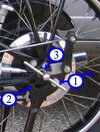Well I removed the wheel and isolated the lug, which promptly fell off (as I suspected it would). The break looks like its been repaired a few times by brazing and a good layer of paint. I suspect the paint had more chance of holding it together than the braze. As you can see from these images (http://jalbum.net/browse/user/album/706932/) the metal on the exposed surfaces of the break is very brittle. In fact it looks carbonised (?). Anyway, my options are clearly installing the new lug that I ordered (if there are any in stock), or the rod into the RFM tubing and then through the rear of the lug, and securing it and refitting the old lug.
The images are at http://jalbum.net/browse/user/album/706932/
Again, thankyou for your help.
Rob
The images are at http://jalbum.net/browse/user/album/706932/
Again, thankyou for your help.
Rob

